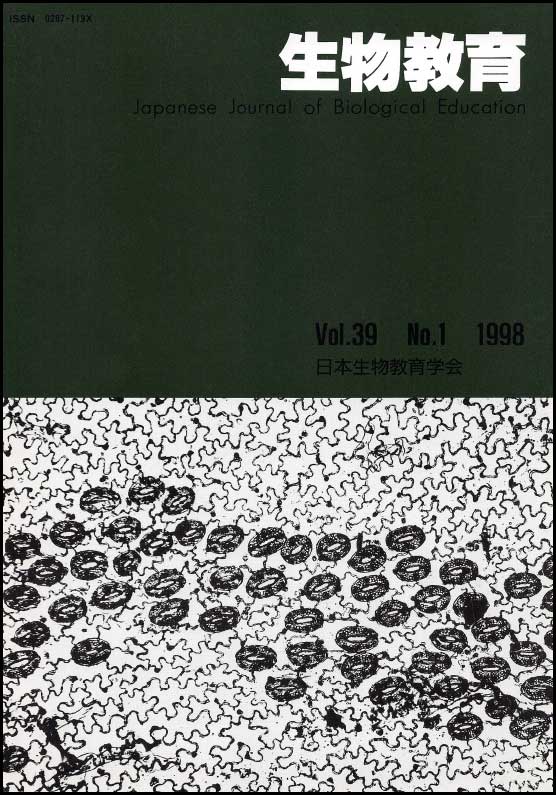
- Issue 3-4 Pages 122-
- Issue 2 Pages 58-
- Issue 1 Pages 2-
- |<
- <
- 1
- >
- >|
-
T. Arakawa, K. Hashimoto1998Volume 39Issue 1 Pages 2-10
Published: 1998
Released on J-STAGE: April 09, 2022
JOURNAL FREE ACCESSExperimental methods to observe the morphology of lepidopteran larvae anaesthetized in water were developed. Lepidopteran larvae are stabilized by an immersion in water which induces hypoxia. Sixth-instar larvae of the rice armyworm, Pseudaletia separata, were anaesthetized in water in order to facilitate observation of their external
morphology. Larval external morphology was then easily observed in detail with a stereomicroscope while anaesthetization in water. Anaesthetization up to 1 hour at 20°C resulted in no noticeable ill effect on the larvae. Larvae treated this way have developed into adult moth by a continuous rearing following the anaesthetization. By using water cooled at 4°C, the duration of anaesthetization without any ill effect on the larvae was prolonged at least to 6 hours. Anaesthetizing treatment in water is suggested as a means of the observation of lepidopteran larval external morphology in science education.
View full abstractDownload PDF (26766K) -
T. Kobayashi1998Volume 39Issue 1 Pages 11-20
Published: 1998
Released on J-STAGE: April 09, 2022
JOURNAL FREE ACCESSThe purpose of the present study was to reconstruct biololgy education in order to develop an ability to scientifically resolve problems.
The six perspectives dealt with are as follows: (1) the particularity of biololgy; (2) the topics of biology education as seen from the development of an ability to scientifically resolve problems; (3) the significance of proto-experiences, etc. in biology education; (4) the content of scientific methodology and the methods of instruction; (5) the way to understand academic capability and the methods of instruction; and (6) the reconstruction of biological concepts.
On the basis of results obtained through the above mentioned perspectives, I comprehensively studied the content of biology education and thereby reconstructed that content of biology education using the “self-creativity of life”·as the superior concept.
View full abstractDownload PDF (27191K)
-
T. Mori, N. Mori1998Volume 39Issue 1 Pages 21-28
Published: 1998
Released on J-STAGE: April 09, 2022
JOURNAL FREE ACCESSThe purpose of this research is to give students better understanding of respiration that breathing by the lungs is not the only way of respiration and some invertebrates whose mouths and noses are indistinct respire without mediating the lungs.
The present authors devised some methods for students'experiments to confirm
that invertebrates discharge carbon dioxide.
1. It was detected that Incilaria fruhstorferi respires through the parts except its
mouth by soaking it in a Bromo Thimol Blue solution. The color of BTB solution changed from green to yellow by carbon dioxide expired from the animal. This color distribution of BTB solution was fixed by animal mucilage.
2. We developed the method to check at the same time animals such as Geothelphusa dehaani living at the border of water and land discharge carbon dioxide into the water and the air.
3. The students understood visually that Pheretima communissima was struggling to demand the air.
4. Shapes of shellfish are quite different from fish. So the students are convinced that it might not breathe. But they could understand that it discharge carbon dioxide as same as fish.
By making experiment with invertebrates as above, in addition to mammals and fishes, the students understood that breathing is the common activity for living in all animals including invertebrates.
View full abstractDownload PDF (20860K)
-
N. Katayama, R. Wallis1998Volume 39Issue 1 Pages 29-38
Published: 1998
Released on J-STAGE: April 09, 2022
JOURNAL FREE ACCESSIn Victoria, a set of Curriculum and Standards Framework (CSF)s cover the compulsory years of schooling (Prep-Year 10). Biology is mainly taught in science through the CSF: Science. In the CSF: Science the biology-related strand “Life and Living” is taught via three sustrands in seven levels over 11 years of schooling. These substrands are “Living Together”, “Structure and Function” and “Biodiversity, Change and Community”. At each level, the CSF provides a set of curriculum focus and learning outcomes with suggested activities to help teachers and parents identify appropriate standards of achievements of students. Some elements of biology are also covered in the CSF: Studies of Society and Environment (with an emphasis on ecology) and the CSF: Health and Physical Education (human physiology, nutrition and health).
There are many “Extension Education Services” for students to encourage their science learning and for teachers to help teach science which are provided by many institutions and organizations in Victoria. To support primary school teachers in their teaching science and technology, a program named STEPS has been developed. In the STEPS, TV programs are provided through SOFNet and current information about STEPS and the “Extension Education Service” is obtainable by accessing its internet webpage.
View full abstractDownload PDF (32463K)
- |<
- <
- 1
- >
- >|